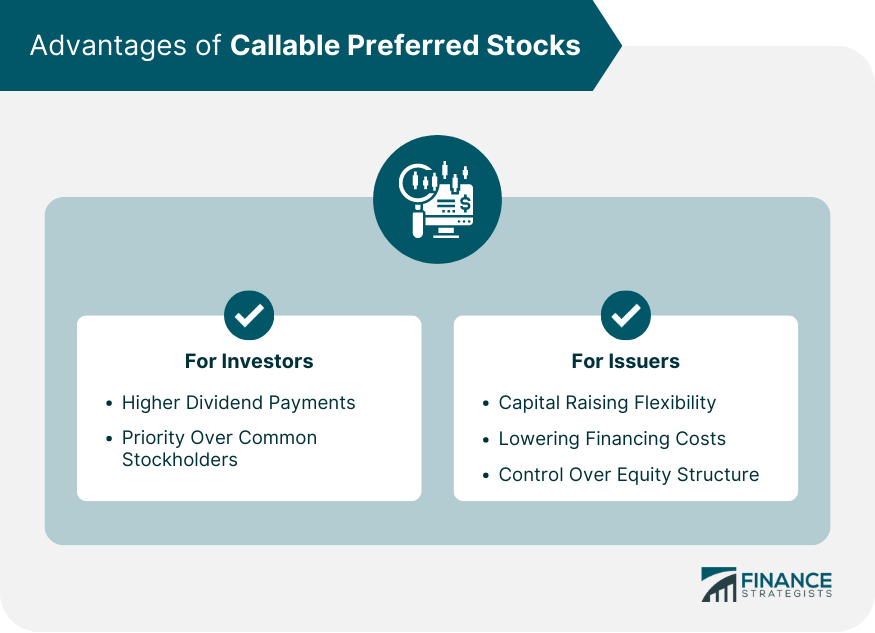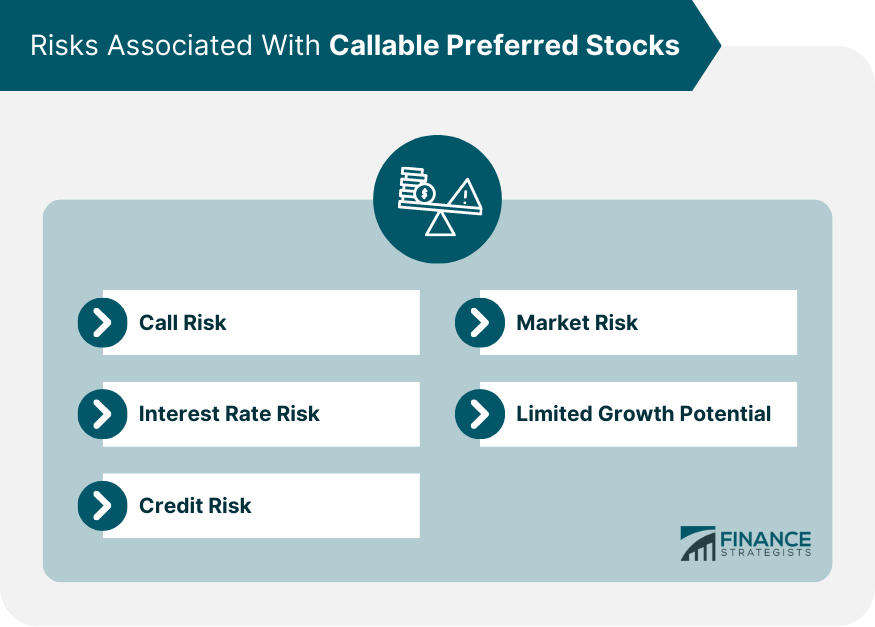A callable preferred stock is a type of preferred stock that grants the issuing company the right, but not the obligation, to repurchase the stock at a specified price after a predetermined date. This feature allows the issuer to retire the preferred shares if interest rates decline or if the company's financial position improves. Callable preferred stocks have several distinguishing features, including a fixed dividend rate, a call provision, and a potential conversion feature that allows investors to exchange their preferred shares for common stock. Companies issue callable preferred stocks for various reasons, such as raising capital with flexibility, lowering financing costs, and managing their equity structure more efficiently. Callable preferred stocks typically pay a fixed dividend rate, providing investors with a stable and predictable income stream. Dividends on callable preferred stocks can be cumulative or non-cumulative. Cumulative dividends accrue if the company misses a dividend payment, while non-cumulative dividends do not accrue if a payment is missed. The call price is the amount the issuer must pay to repurchase the callable preferred stock. The call price is often set at a premium above the stock's par value to compensate investors for the call risk. The call date is the earliest date the issuer can exercise its right to repurchase the callable preferred stock. The call protection period is the time between the issuance of the callable preferred stock and the first call date. During this period, the issuer cannot exercise its call option, providing investors with a degree of protection. Some callable preferred stocks have a conversion feature that allows investors to convert their preferred shares into common stock at a predetermined ratio. This feature provides investors with the potential for capital appreciation if the common stock's value increases. The conversion ratio determines the number of common shares an investor will receive for each preferred share they convert. The conversion price is the common stock's price at which the conversion takes place. Callable preferred stocks often have credit ratings assigned by rating agencies, indicating the issuer's creditworthiness and the stock's risk level. Callable preferred stocks typically pay higher dividends compared to common stocks, providing investors with a consistent income stream. In the event of liquidation or bankruptcy, preferred stockholders have priority over common stockholders when it comes to dividend payments and asset distribution. Callable preferred stocks provide companies with flexibility in raising capital, as they can retire the stock when it is advantageous to do so. If interest rates decline or the company's credit rating improves, the issuer can call the preferred stock, potentially lowering its financing costs by issuing new preferred shares at a lower dividend rate. Callable preferred stocks give the issuer control over its equity structure by allowing it to retire preferred shares and replace them with common stock or other securities. Investors face call risk when the issuer exercises its right to repurchase the callable preferred stock, potentially causing the investor to lose future dividend income and seek alternative investments. Callable preferred stocks are sensitive to changes in interest rates. If rates rise, the market value of the preferred stock may decline, as investors seek higher-yielding investments. Conversely, if interest rates fall, the issuer may call the preferred stock, forcing investors to reinvest at lower rates. Investors in callable preferred stocks are exposed to credit risk, as the issuer's financial health may deteriorate, leading to missed dividend payments or, in extreme cases, bankruptcy. Callable preferred stocks are subject to market risk, as their prices can fluctuate due to factors such as investor sentiment, economic conditions, and industry-specific events. Compared to common stocks, callable preferred stocks generally have limited growth potential, as their dividends are fixed and their value is less likely to appreciate significantly. Investors should evaluate the dividend yield and rate of callable preferred stocks to assess their potential income generation. A higher yield might be tempting, but it's important to consider the risk of early call by the issuer. It's essential to understand the call features and protection period of a callable preferred stock, as these factors influence the investment's potential income and risks. Investors should consider the credit ratings of callable preferred stocks to gauge the issuer's creditworthiness and the investment's overall risk. If a callable preferred stock has a conversion feature, investors should evaluate the conversion ratio and price to determine the potential for capital appreciation. Callable preferred stocks can serve as a source of income for investors seeking stable dividend payments and lower risk compared to common stocks. Investing in callable preferred stocks can provide diversification benefits by adding a different asset class to an investor's portfolio, potentially reducing overall risk. Callable preferred stocks with a conversion feature can help investors hedge against interest rate risk, as the option to convert to common stock may provide potential capital appreciation if interest rates rise. The market for callable preferred stocks consists of various issuers, including corporations, financial institutions, and utilities. These stocks are traded on stock exchanges and can be bought and sold through brokerage accounts. Several indexes and funds track the performance of callable preferred stocks, providing investors with benchmarks and investment options. Examples include the S&P U.S. Preferred Stock Index and the iShares U.S. Preferred Stock ETF (PFF). Callable preferred stock issuance trends can be influenced by factors such as interest rates, economic conditions, and corporate financing needs. In periods of low interest rates, companies may be more likely to issue callable preferred stocks to lock in lower financing costs while retaining the option to call the stock if rates decline further. Callable preferred stocks are a unique type of preferred stock that provides investors with higher dividend payments and priority over common stockholders. They offer issuers flexibility in raising capital and managing their equity structure. However, investors must consider the risks associated with callable preferred stocks, such as call risk, interest rate risk, and limited growth potential. Callable preferred stocks play a crucial role in the financial market by providing companies with an alternative means of raising capital and giving investors an additional asset class to diversify their portfolios and generate income. The future outlook for callable preferred stocks will likely be influenced by factors such as interest rates, economic conditions, and investor appetite for income-generating investments. As the financial market continues to evolve, callable preferred stocks will remain a relevant and valuable investment option for both issuers and investors.What Are Callable Preferred Stocks?
Key Features of Callable Preferred Stocks
Dividends
Fixed Dividend Rate
Cumulative vs Non-cumulative Dividends
Call Provision
Call Price
Call Date
Call Protection Period
Conversion Feature
Convertible vs Non-convertible Callable Preferred Stocks
Conversion Ratio and Price
Credit Ratings
Advantages of Callable Preferred Stocks
For Investors
Higher Dividend Payments
Priority over Common Stockholders
For Issuers
Capital Raising Flexibility
Lowering Financing Costs
Control Over Equity Structure

Risks Associated With Callable Preferred Stocks
Call Risk
Interest Rate Risk
Credit Risk
Market Risk
Limited Growth Potential

Investing in Callable Preferred Stocks
Considerations for Investors
Dividend Yield and Rate
Call Features and Protection Period
Credit Ratings
Conversion Features
Investment Strategies
Income Generation
Portfolio Diversification
Hedging Interest Rate Risk
Callable Preferred Stocks in the Financial Market
Market for Callable Preferred Stocks
Callable Preferred Stock Indexes and Funds
Callable Preferred Stock Issuance Trends
Conclusion
Callable Preferred Stock FAQs
Callable Preferred Stock is a type of preferred stock that gives the issuer the option to redeem the shares at a predetermined price and time. This means that the issuer has the right to "call" the stock and buy it back from shareholders. Callable Preferred Stock typically pays a fixed dividend rate, which may be higher than the dividend rate of common stock.
Callable Preferred Stock works by giving the issuer the right to redeem the shares at a specified call price and date. If the issuer decides to call the stock, shareholders will receive the call price per share, which may be higher or lower than the market price of the stock at the time of the call. If the issuer does not call the stock, shareholders will continue to receive the fixed dividend rate until the stock is called or the issuer redeems it at maturity.
Investing in Callable Preferred Stock offers several benefits, including a fixed dividend rate, lower risk compared to common stock, and potential capital appreciation if the stock is called at a premium. Callable Preferred Stock is also generally less volatile than common stock, which can make it a good choice for investors looking for stable, reliable income.
The main risk of investing in Callable Preferred Stock is the potential for the issuer to call the stock before maturity, which can result in a loss of potential income and capital appreciation. Additionally, the fixed dividend rate of Callable Preferred Stock may not keep pace with inflation, which can erode the value of the investment over time. Finally, investors may be exposed to interest rate risk, as changes in interest rates can affect the value of the stock.
Investors can evaluate Callable Preferred Stock by looking at factors such as the credit rating of the issuer, the dividend rate, the call price and date, and the current market price of the stock. It's also important to evaluate the issuer's financial health and stability, as well as the performance of the industry in which it operates. Finally, investors should consider their own investment goals and risk tolerance before investing in Callable Preferred Stock.
True Tamplin is a published author, public speaker, CEO of UpDigital, and founder of Finance Strategists.
True is a Certified Educator in Personal Finance (CEPF®), author of The Handy Financial Ratios Guide, a member of the Society for Advancing Business Editing and Writing, contributes to his financial education site, Finance Strategists, and has spoken to various financial communities such as the CFA Institute, as well as university students like his Alma mater, Biola University, where he received a bachelor of science in business and data analytics.
To learn more about True, visit his personal website or view his author profiles on Amazon, Nasdaq and Forbes.















